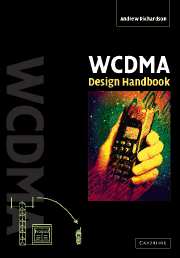Book contents
- Frontmatter
- Dedication
- Contents
- Preface
- Acknowledgements
- List of abbreviations
- 1 Introduction
- 2 WCDMA in a nutshell
- 3 Spreading codes and modulation
- 4 Physical layer
- 5 RF aspects
- 6 Chip rate processing functions
- 7 Symbol rate processing functions
- 8 Layer 2 - medium access control (MAC)
- 9 Layer 2 - RLC
- 10 PDCP and BMC protocols
- 11 Layer 3 - RRC
- 12 Measurements
- 13 NAS
- 14 Idle mode functions
- Appendix
- References
- Index
10 - PDCP and BMC protocols
Published online by Cambridge University Press: 05 October 2013
- Frontmatter
- Dedication
- Contents
- Preface
- Acknowledgements
- List of abbreviations
- 1 Introduction
- 2 WCDMA in a nutshell
- 3 Spreading codes and modulation
- 4 Physical layer
- 5 RF aspects
- 6 Chip rate processing functions
- 7 Symbol rate processing functions
- 8 Layer 2 - medium access control (MAC)
- 9 Layer 2 - RLC
- 10 PDCP and BMC protocols
- 11 Layer 3 - RRC
- 12 Measurements
- 13 NAS
- 14 Idle mode functions
- Appendix
- References
- Index
Summary
In this chapter we consider two final layer 2 protocols, the PDCP and the BMC protocols. The PDCP provides the NAS with packet data transfer services such as header compression and lossless SRNS relocation. The BMC, for R99, provides cell broadcast services.
PDCP architecture and operation
Figure 10.1 illustrates the basic structure of the PDCP architecture. The PDCP is defined for the PS domain only. At the inputs to the PDCP layer are the PDCP SAPs. The RB is defined as the input to the PDCP layer for the PS domain. An RB is the transfer service that layer 2 provides to the higher layer protocols. The RAB is defined as the input to the AS and is a transfer service that the AS provides for NAS. An RAB is made from an RB and an Iu bearer between the RNC and CN.
The PDCP layer for R99 provides HC functions and support for lossless SRNS relocation. HC is defined using standard algorithms of which RFC 2507 is the one used for R99 [30].
PDCP PDUs
Figure 10.2 illustrates the three different PDUs that are defined for the PDCP layer operation: one when HC is not utilised, one when HC is utilised and one that also includes the SNs used as part of the PDCP SN synchronisation. The PDCP SeqNum PDU is used only when the PDCP layer entities lose synchronisation, e.g. as part of the RLC reset procedure.
Information
- Type
- Chapter
- Information
- WCDMA Design Handbook , pp. 337 - 348Publisher: Cambridge University PressPrint publication year: 2005
